Shaojie Wang
Rethinking the Understanding Ability across LLMs through Mutual Information
May 25, 2025Abstract:Recent advances in large language models (LLMs) have revolutionized natural language processing, yet evaluating their intrinsic linguistic understanding remains challenging. Moving beyond specialized evaluation tasks, we propose an information-theoretic framework grounded in mutual information (MI) to achieve this. We formalize the understanding as MI between an input sentence and its latent representation (sentence-level MI), measuring how effectively input information is preserved in latent representation. Given that LLMs learn embeddings for individual tokens, we decompose sentence-level MI into token-level MI between tokens and sentence embeddings, establishing theoretical bounds connecting these measures. Based on this foundation, we theoretically derive a computable lower bound for token-level MI using Fano's inequality, which directly relates to token-level recoverability-the ability to predict original tokens from sentence embedding. We implement this recoverability task to comparatively measure MI across different LLMs, revealing that encoder-only models consistently maintain higher information fidelity than their decoder-only counterparts, with the latter exhibiting a distinctive late-layer "forgetting" pattern where mutual information is first enhanced and then discarded. Moreover, fine-tuning to maximize token-level recoverability consistently improves understanding ability of LLMs on tasks without task-specific supervision, demonstrating that mutual information can serve as a foundation for understanding and improving language model capabilities.
SRPO: A Cross-Domain Implementation of Large-Scale Reinforcement Learning on LLM
Apr 22, 2025Abstract:Recent advances of reasoning models, exemplified by OpenAI's o1 and DeepSeek's R1, highlight the significant potential of Reinforcement Learning (RL) to enhance the reasoning capabilities of Large Language Models (LLMs). However, replicating these advancements across diverse domains remains challenging due to limited methodological transparency. In this work, we present two-Staged history-Resampling Policy Optimization (SRPO), which surpasses the performance of DeepSeek-R1-Zero-32B on the AIME24 and LiveCodeBench benchmarks. SRPO achieves this using the same base model as DeepSeek (i.e. Qwen2.5-32B), using only about 1/10 of the training steps required by DeepSeek-R1-Zero-32B, demonstrating superior efficiency. Building upon Group Relative Policy Optimization (GRPO), we introduce two key methodological innovations: (1) a two-stage cross-domain training paradigm designed to balance the development of mathematical reasoning and coding proficiency, and (2) History Resampling (HR), a technique to address ineffective samples. Our comprehensive experiments validate the effectiveness of our approach, offering valuable insights into scaling LLM reasoning capabilities across diverse tasks.
SES: Bridging the Gap Between Explainability and Prediction of Graph Neural Networks
Jul 16, 2024



Abstract:Despite the Graph Neural Networks' (GNNs) proficiency in analyzing graph data, achieving high-accuracy and interpretable predictions remains challenging. Existing GNN interpreters typically provide post-hoc explanations disjointed from GNNs' predictions, resulting in misrepresentations. Self-explainable GNNs offer built-in explanations during the training process. However, they cannot exploit the explanatory outcomes to augment prediction performance, and they fail to provide high-quality explanations of node features and require additional processes to generate explainable subgraphs, which is costly. To address the aforementioned limitations, we propose a self-explained and self-supervised graph neural network (SES) to bridge the gap between explainability and prediction. SES comprises two processes: explainable training and enhanced predictive learning. During explainable training, SES employs a global mask generator co-trained with a graph encoder and directly produces crucial structure and feature masks, reducing time consumption and providing node feature and subgraph explanations. In the enhanced predictive learning phase, mask-based positive-negative pairs are constructed utilizing the explanations to compute a triplet loss and enhance the node representations by contrastive learning.
Graph Structure Prompt Learning: A Novel Methodology to Improve Performance of Graph Neural Networks
Jul 16, 2024



Abstract:Graph neural networks (GNNs) are widely applied in graph data modeling. However, existing GNNs are often trained in a task-driven manner that fails to fully capture the intrinsic nature of the graph structure, resulting in sub-optimal node and graph representations. To address this limitation, we propose a novel Graph structure Prompt Learning method (GPL) to enhance the training of GNNs, which is inspired by prompt mechanisms in natural language processing. GPL employs task-independent graph structure losses to encourage GNNs to learn intrinsic graph characteristics while simultaneously solving downstream tasks, producing higher-quality node and graph representations. In extensive experiments on eleven real-world datasets, after being trained by GPL, GNNs significantly outperform their original performance on node classification, graph classification, and edge prediction tasks (up to 10.28%, 16.5%, and 24.15%, respectively). By allowing GNNs to capture the inherent structural prompts of graphs in GPL, they can alleviate the issue of over-smooth and achieve new state-of-the-art performances, which introduces a novel and effective direction for GNN research with potential applications in various domains.
A bioinspired three-stage model for camouflaged object detection
May 22, 2023Abstract:Camouflaged objects are typically assimilated into their backgrounds and exhibit fuzzy boundaries. The complex environmental conditions and the high intrinsic similarity between camouflaged targets and their surroundings pose significant challenges in accurately locating and segmenting these objects in their entirety. While existing methods have demonstrated remarkable performance in various real-world scenarios, they still face limitations when confronted with difficult cases, such as small targets, thin structures, and indistinct boundaries. Drawing inspiration from human visual perception when observing images containing camouflaged objects, we propose a three-stage model that enables coarse-to-fine segmentation in a single iteration. Specifically, our model employs three decoders to sequentially process subsampled features, cropped features, and high-resolution original features. This proposed approach not only reduces computational overhead but also mitigates interference caused by background noise. Furthermore, considering the significance of multi-scale information, we have designed a multi-scale feature enhancement module that enlarges the receptive field while preserving detailed structural cues. Additionally, a boundary enhancement module has been developed to enhance performance by leveraging boundary information. Subsequently, a mask-guided fusion module is proposed to generate fine-grained results by integrating coarse prediction maps with high-resolution feature maps. Our network surpasses state-of-the-art CNN-based counterparts without unnecessary complexities. Upon acceptance of the paper, the source code will be made publicly available at https://github.com/clelouch/BTSNet.
PROVES: Establishing Image Provenance using Semantic Signatures
Oct 21, 2021

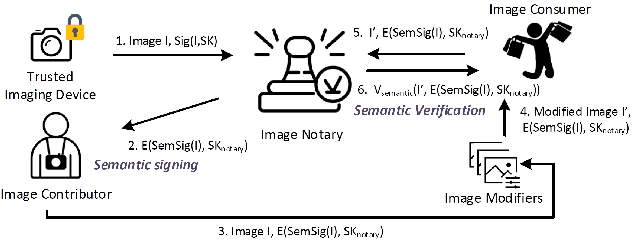
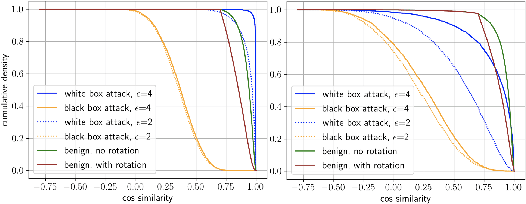
Abstract:Modern AI tools, such as generative adversarial networks, have transformed our ability to create and modify visual data with photorealistic results. However, one of the deleterious side-effects of these advances is the emergence of nefarious uses in manipulating information in visual data, such as through the use of deep fakes. We propose a novel architecture for preserving the provenance of semantic information in images to make them less susceptible to deep fake attacks. Our architecture includes semantic signing and verification steps. We apply this architecture to verifying two types of semantic information: individual identities (faces) and whether the photo was taken indoors or outdoors. Verification accounts for a collection of common image transformation, such as translation, scaling, cropping, and small rotations, and rejects adversarial transformations, such as adversarially perturbed or, in the case of face verification, swapped faces. Experiments demonstrate that in the case of provenance of faces in an image, our approach is robust to black-box adversarial transformations (which are rejected) as well as benign transformations (which are accepted), with few false negatives and false positives. Background verification, on the other hand, is susceptible to black-box adversarial examples, but becomes significantly more robust after adversarial training.
Towards Robust Sensor Fusion in Visual Perception
Jun 23, 2020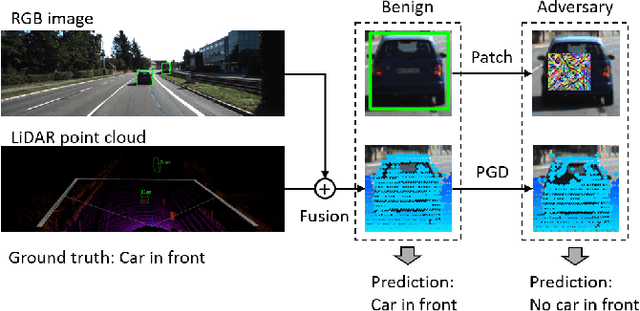
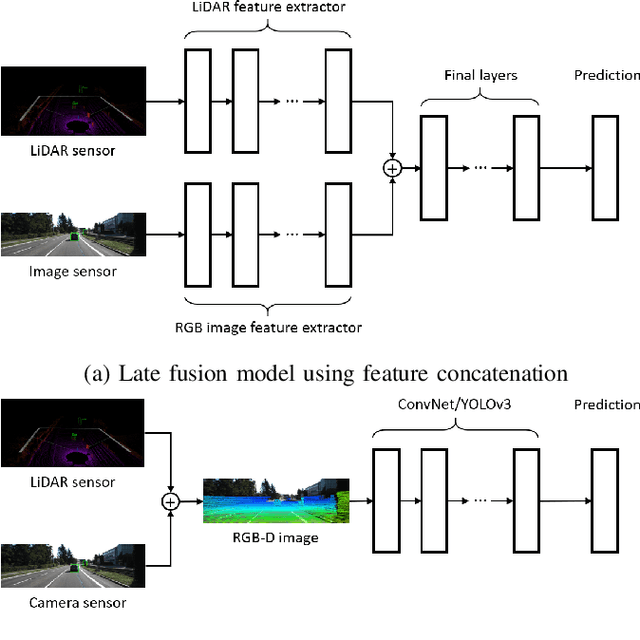
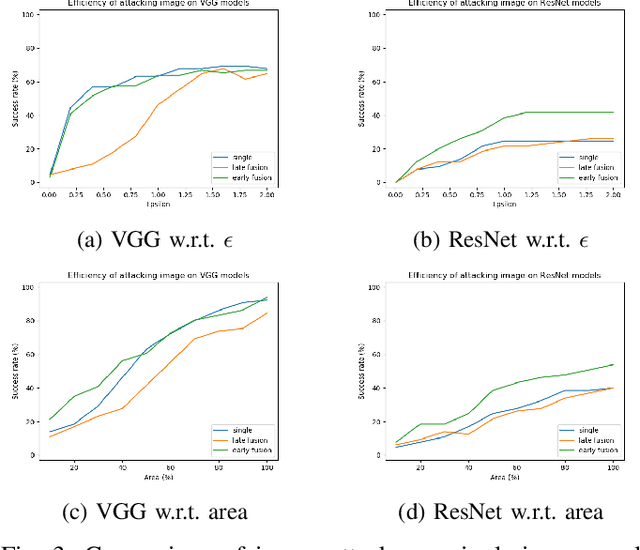
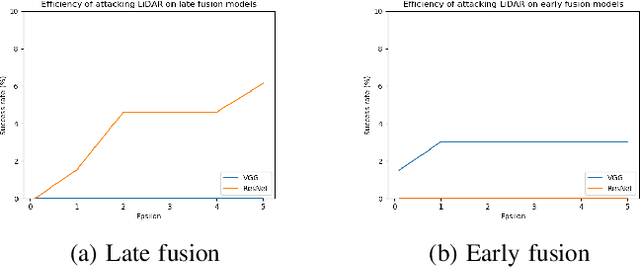
Abstract:We study the problem of robust sensor fusion in visual perception, especially under the autonomous driving settings. We evaluate the robustness of RGB camera and LiDAR sensor fusion for binary classification and object detection. In this work, we are interested in the behavior of different fusion methods under adversarial attacks on different sensors. We first train both classification and detection models with early fusion and late fusion, then apply different combinations of adversarial attacks on both sensor inputs for evaluation. We also study the effectiveness of adversarial attacks with varying budgets. Experiment results show that while sensor fusion models are generally vulnerable to adversarial attacks, late fusion method is more robust than early fusion. The results also provide insights on further obtaining robust sensor fusion models.
Weakly Supervised Object Localization with Inter-Intra Regulated CAMs
Nov 19, 2019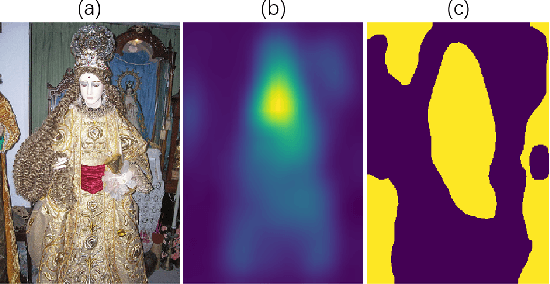
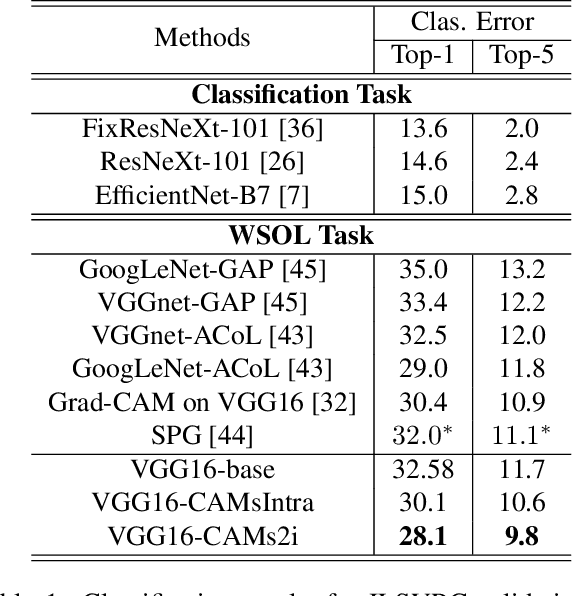
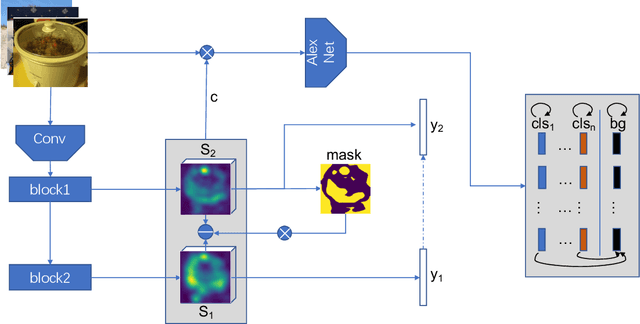
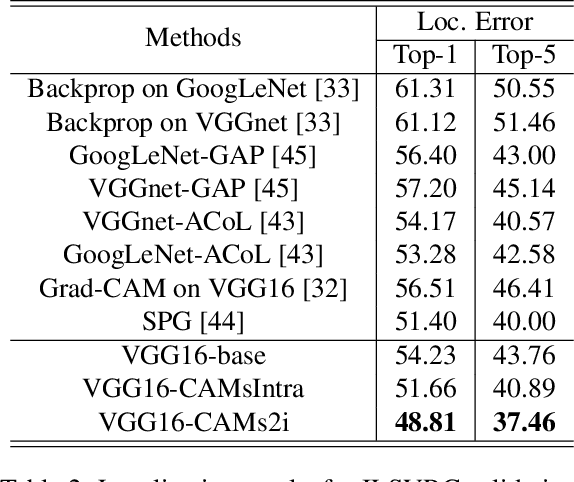
Abstract:Weakly supervised object localization (WSOL) aims to locate objects in images by learning only from image-level labels. Current methods are trying to obtain localization results relying on Class Activation Maps (CAMs). Usually, they propose additional CAMs or feature maps generated from internal layers of deep networks to encourage different CAMs to be either \textbf{adversarial} or \textbf{cooperated} with each other. In this work, instead of following one of the two main approaches before, we analyze their internal relationship and propose a novel intra-sample strategy which regulates two CAMs of the same sample, generated from different classifiers, to dynamically adapt each of their pixels involved in adversarial or cooperative process based on their own values. We mathematically demonstrate that our approach is a more general version of the current state-of-the-art method with less hyper-parameters. Besides, we further develop an inter-sample criterion module for our WSOL task, which is originally proposed in co-segmentation problems, to refine generated CAMs of each sample. The module considers a subgroup of samples under the same category and regulates their object regions. With experiment on two widely-used datasets, we show that our proposed method significantly outperforms existing state-of-the-art, setting a new record for weakly-supervised object localization.
Weakly Supervised Localization Using Background Images
Sep 11, 2019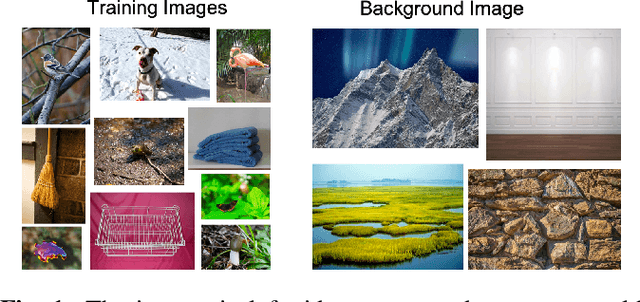
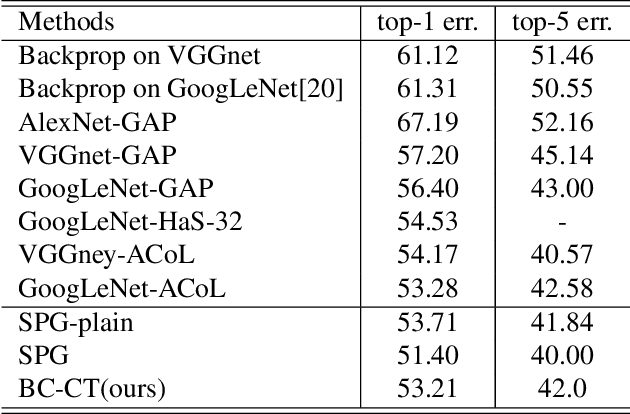
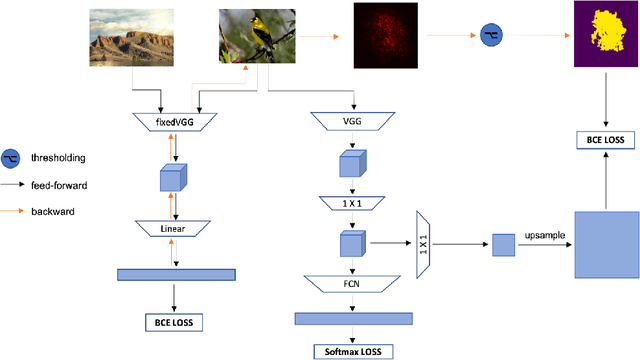
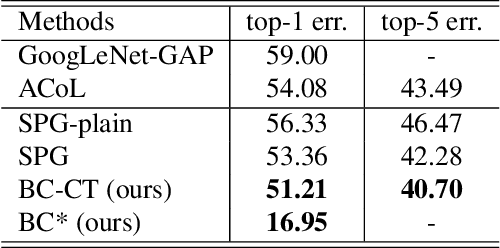
Abstract:Weakly Supervised Object Localization (WSOL) methodsusually rely on fully convolutional networks in order to ob-tain class activation maps(CAMs) of targeted labels. How-ever, these networks always highlight the most discriminativeparts to perform the task, the located areas are much smallerthan entire targeted objects. In this work, we propose a novelend-to-end model to enlarge CAMs generated from classifi-cation models, which can localize targeted objects more pre-cisely. In detail, we add an additional module in traditionalclassification networks to extract foreground object propos-als from images without classifying them into specific cate-gories. Then we set these normalized regions as unrestrictedpixel-level mask supervision for the following classificationtask. We collect a set of images defined as Background ImageSet from the Internet. The number of them is much smallerthan the targeted dataset but surprisingly well supports themethod to extract foreground regions from different pictures.The region extracted is independent from classification task,where the extracted region in each image covers almost en-tire object rather than just a significant part. Therefore, theseregions can serve as masks to supervise the response mapgenerated from classification models to become larger andmore precise. The method achieves state-of-the-art results onCUB-200-2011 in terms of Top-1 and Top-5 localization er-ror while has a competitive result on ILSVRC2016 comparedwith other approaches.
How to Make a BLT Sandwich? Learning to Reason towards Understanding Web Instructional Videos
Dec 06, 2018



Abstract:Understanding web instructional videos is an essential branch of video understanding in two aspects. First, most existing video methods focus on short-term actions for a-few-second-long video clips; these methods are not directly applicable to long videos. Second, unlike unconstrained long videos, e.g., movies, instructional videos are more structured in that they have step-by-step procedure constraining the understanding task. In this paper, we study reasoning on instructional videos via question-answering (QA). Surprisingly, it has not been an emphasis in the video community despite its rich applications. We thereby introduce YouQuek, an annotated QA dataset for instructional videos based on the recent YouCook2. The questions in YouQuek are not limited to cues on one frame but related to logical reasoning in the temporal dimension. Observing the lack of effective representations for modeling long videos, we propose a set of carefully designed models including a novel Recurrent Graph Convolutional Network (RGCN) that captures both temporal order and relation information. Furthermore, we study multiple modalities including description and transcripts for the purpose of boosting video understanding. Extensive experiments on YouQuek suggest that RGCN performs the best in terms of QA accuracy and a better performance is gained by introducing human annotated description.
 Add to Chrome
Add to Chrome Add to Firefox
Add to Firefox Add to Edge
Add to Edge